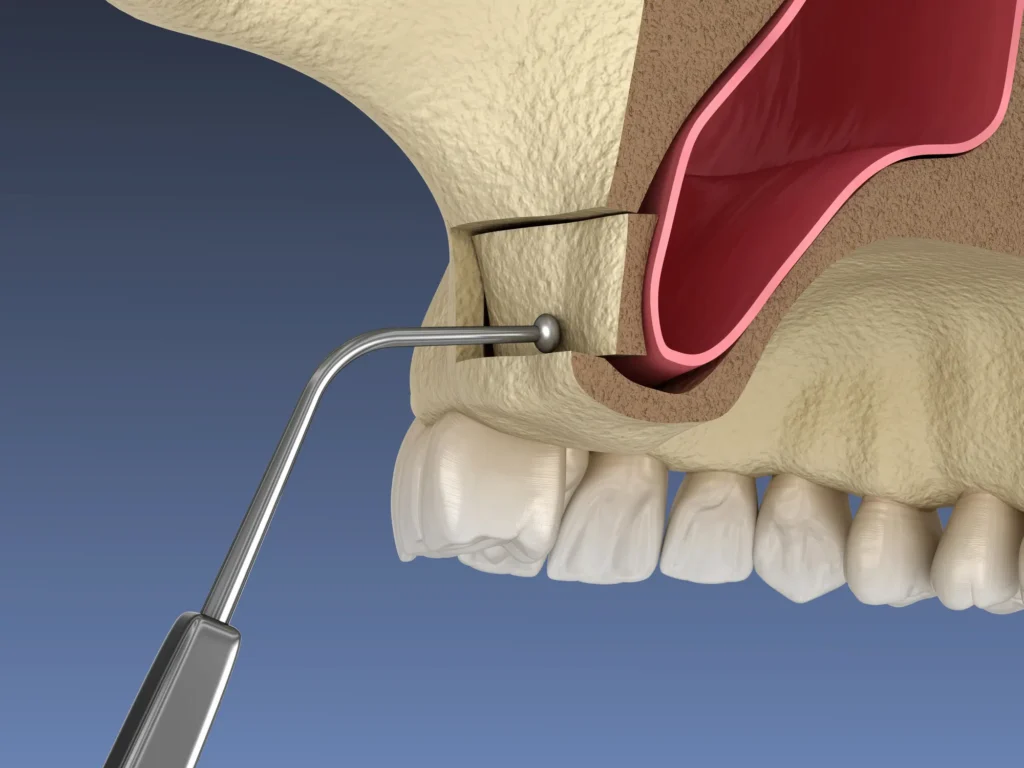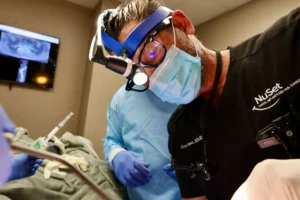In recent years, more people are choosing dental implants, which means sinus lifts are also becoming more common. If you’re scheduled for a sinus lift and have some questions, you’re not alone.
A sinus lift is a common treatment for people with bone loss who want to replace missing teeth with implants. It can sound a little overwhelming, but it’s a safe and effective way to ensure your implants have the support they need to last long-term.
Let’s discuss everything you need to know about sinus lift, why it’s done, how the surgery works, and what to expect before and after.
What is a Sinus Lift for a Dental Implant?
A sinus lift is a procedure that helps create more bone in the upper jaw. This is important for people who want dental implants but don’t have enough bone to support them. The procedure involves adding bone to the area between your upper teeth and your sinus cavities.
Your dentist or oral surgeon will gently lift the sinus membrane to make room for the bone graft. Once the bone heals, it provides a solid foundation for your dental implant.
Why Would You Need a Sinus Lift?
You may need a sinus lift if your upper jaw doesn’t have enough bone to hold a dental implant securely. This is a common issue, and there are several reasons why it happens.
Periodontal Gum Disease
If you’ve had advanced gum disease, it can damage the bone that supports your teeth. Over time, this bone loss can make it difficult to place implants without extra help. A sinus lift can rebuild the bone so you can get a stable implant.
Tooth Loss in the Upper Jaw
Losing a tooth in your upper jaw, especially in the back, can cause the bone in that area to shrink over time. Without a tooth to keep the bone in place, it begins to wear away. This bone loss makes it harder to place an implant because there isn’t enough support.
Bone Resorption After Tooth Loss
After losing a tooth, your body may start to reabsorb the bone where the tooth used to be. This is a natural process, but it can leave you with less bone than you need for an implant. When too much bone is lost, a sinus lift adds more bone to the area, making it possible to place the implant.
Without enough bone, your dental implants might not stay secure or could even fail. A sinus lift gives you the chance to replace missing teeth with implants by rebuilding the bone that has been lost. If your dentist suggests this procedure, it’s to make sure your implants have the strong support they need to last for many years.
How are Sinus Lifts Done?
A sinus lift is a straightforward procedure, but it does involve surgery. Your oral surgeon will take detailed scans and X-rays of your jaw and sinuses before the procedure to make sure everything is planned properly.
During the surgery, our dental surgeon will start by making a small incision in your gum tissue where the bone is thin. This exposes the bone underneath.
Once the bone is exposed, the surgeon will carefully cut a small window in it. This gives them access to your sinus membrane, which is gently lifted up to create space for the bone graft.
After lifting the sinus membrane, the surgeon will place bone graft material into the space created. This bone graft can come from your own body, a donor, or be synthetic. The goal is to create enough bone for the dental implant to hold onto.
Once the bone graft is in place, the surgeon will stitch up the incision in your gum. Over time, the new bone will integrate with your jawbone.
Our team will guide you through each step of the recovery process, ensuring you heal properly. At NuSet, we take pride in using the latest techniques and technology to make sure your sinus lift is successful and prepares you for a stable dental implant.

How Long Will It Take to Place the Implants After My Sinus Lift?
In some cases, your implant can be placed at the same time as your sinus lift, avoiding the need for a second surgery. However, the timing often depends on how much bone needs to be added during the procedure. If a larger amount of bone is required, it may take longer for the new bone to fully fuse with your existing bone.
At NuSet Dental Implant and Oral Surgery, we’ll closely monitor your healing and let you know when the bone is strong enough to support the implant. Typically, this can take anywhere from 4 to 12 months.
During this time, we can provide you with temporary teeth so you don’t have to wait to enjoy a complete smile. Your oral surgeon will give you a personalized timeline based on your healing progress and specific needs.
Contact Us at NuSet For a Stronger, Healthier Smile!
A sinus lift could be the solution you need to get stable, long-lasting dental implants. This procedure helps create enough bone in your upper jaw to securely hold your implants. While it takes some time to heal, the end result is worth it—strong, comfortable implants that last for years.
At NuSet Dental Implant and Oral Surgery, we will support you throughout the entire process. From preparation to recovery, our team is here to ensure your comfort and answer any questions you have. If you’re considering dental implants and think a sinus lift might be necessary, book a consultation with us to get started!
Frequently Asked Questions
How painful is a sinus lift for an implant?
A sinus lift is usually not very painful. During the surgery, you’ll be given anesthesia, so you won’t feel anything. After the procedure, you may have some swelling and mild discomfort, but this can be managed with pain medication. Most people feel better within a few days.
What is the downside of a sinus lift?
Like any surgery, there are some risks. The most common issues are swelling, discomfort, and bleeding. In rare cases, the sinus membrane could tear, but your surgeon can usually repair it during the procedure. Recovery can take a few months before you can get your implants, which may feel like a long wait. However, the benefits usually outweigh these concerns.
Why do I need a sinus lift for dental implants?
If there isn’t enough bone in your upper jaw, a sinus lift helps create the support your dental implants need. Without enough bone, the implant may not stay in place or could fail. A sinus lift ensures there’s enough bone to hold your implant securely for the long term.
How is a dental sinus lift done?
The surgeon will make a small cut in your gum to expose the bone. They will carefully lift the sinus membrane and place bone graft material in the space created. The incision will then be stitched up, and the bone will be left to heal and grow. Once the bone is strong enough, your dental implant can be placed.





